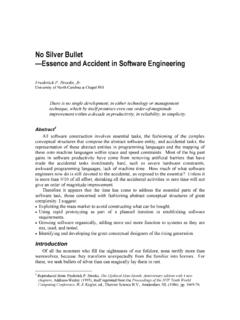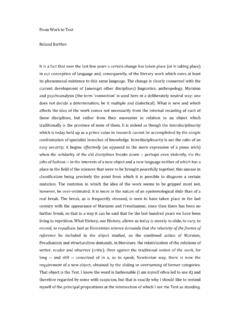Transcription of Collective Dynamics of Small-World Networks
1 Nature Macmillan Publishers Ltd 19988typically slower than,1 km s 1) might differ significantly fromwhat is assumed by current modelling efforts27. The expectedequation-of-state differences among small bodies (ice versus rock,for instance) presents another dimension of study; having recentlyadapted our code for massively parallel architectures (K. M. Olsonand , manuscript in preparation), we are now ready to perform amore comprehensive exploratory simulations presented here suggest that when ayoung, non-porous asteroid (if such exist) suffers extensive impactdamage, the resulting fracture pattern largely defines the asteroid sresponse to future impacts. The stochastic nature of collisionsimplies that small asteroid interiors may be as diverse as theirshapes and spin states.
2 Detailed numerical simulations of impacts,using accurate shape models and rheologies, could shed light onhow asteroid collisional response depends on internal configurationand shape, and hence on how planetesimals evolve. Detailedsimulations are also required before one can predict the quantitativeeffects of nuclear explosions on Earth-crossing comets andasteroids, either for hazard mitigation28through disruption anddeflection, or for resource exploitation29. Such predictions wouldrequire detailed reconnaissance concerning the composition andinternal structure of the targeted 4 February; accepted 18 March Asphaug, E. & Melosh, H. J. The Stickney impact of Phobos: A dynamical ,144 164(1993).2. Asphaug, al. Mechanical and geological effects of impact cratering on ,158 184(1996).
3 3. Nolan, M. C., Asphaug, E., Melosh, H. J. & Greenberg, R. Impact craters on asteroids: Does strength orgravity control their size?Icarus124,359 371 (1996).4. Love, S. J. & Ahrens, T. J. Catastrophic impacts on gravity dominated ,141 155(1996).5. Melosh, H. J. & Ryan, E. V. Asteroids: Shattered but not ,562 564 (1997).6. Housen, K. R., Schmidt, R. M. & Holsapple, K. A. Crater ejecta scaling laws: Fundamental forms basedon dimensional Geophys. ,2485 2499 (1983).7. Holsapple, K. A. & Schmidt, R. M. Point source solutions and coupling parameters in Geophys. ,6350 6376 (1987).8. Housen, K. R. & Holsapple, K. A. On the fragmentation of asteroids and planetary ,226 253 (1990).9. Benz, W. & Asphaug, E. Simulations of brittle solids using smooth particle ,253 265 (1995).
4 10. Asphaug, al. Mechanical and geological effects of impact cratering on ,158 184(1996).11. Hudson, R. S. & Ostro, S. J. Shape of asteroid 4769 Castalia (1989 PB) from inversion of radar ,940 943 (1994).12. Ostro, S. al. Asteroid radar ,1490 1502 (1991).13. Ahrens, T. J. & O Keefe, J. D. inImpact and Explosion Cratering(eds Roddy, D. J., Pepin, R. O. &Merrill, R. B.) 639 656 (Pergamon, New York, 1977).14. Tillotson, J. H. Metallic equations of state for hypervelocity impact. (General Atomic Report GA-3216,San Diego, 1962).15. Nakamura, A. & Fujiwara, A. Velocity distribution of fragments formed in a simulated ,132 146 (1991).16. Benz, W. & Asphaug, E. Simulations of brittle solids using smooth particle ,253 265 (1995).
5 17. Bottke, W. F., Nolan, M. C., Greenberg, R. & Kolvoord, R. A. Velocity distributions among ,255 268 (1994).18. Belton, M. J. al. Galileo encounter with 951 Gaspra First pictures of an ,1647 1652 (1992).19. Belton, M. J. al. Galileo s encounter with 243 Ida: An overview of the imaging ,1 19 (1996).20. Asphaug, E. & Melosh, H. J. The Stickney impact of Phobos: A dynamical ,144 164(1993).21. Asphaug, al. Mechanical and geological effects of impact cratering on ,158 184(1996).22. Housen, K. R., Schmidt, R. M. & Holsapple, K. A. Crater ejecta scaling laws: Fundamental forms basedon dimensional Geophys. ,2485 2499 (1983).23. Veverka, al. NEAR s flyby of 253 Mathilde: Images of a C ,2109 2112 (1997).24. Asphaug, al.
6 Impact evolution of icy Planet. Sci. Conf. (Abstr.)XXVIII,63 64(1997).25. Love, S. G., Ho rz, F. & Brownlee, D. E. Target porosity effects in impact cratering and ,216 224 (1993).26. Fujiwara, A., Cerroni, P., Davis, D. R., Ryan, E. V. & DiMartino, M. inAsteroids II(eds Binzel, R. P.,Gehrels, T. & Matthews, A. S.) 240 265 (Univ. Arizona Press, Tucson, 1989).27. Davis, D. R. & Farinella, P. Collisional evolution of Edgeworth-Kuiper Belt ,50 60(1997).28. Ahrens, T. J. & Harris, A. W. Deflection and fragmentation of near-Earth ,429 433 (1992). of Near-Earth Space(eds Lewis, J. S., Matthews, M. S. & Guerrieri, M. L.) (Univ. ArizonaPress, Tucson, 1993). work was supported by NASA s Planetary Geology and Geophysics and requests for materials should be addressed to (e-mail: to nature440 NATURE|VOL 393|4 JUNE 1998 Collectivedynamicsof Small-World networksDuncan J.)
7 Watts*& Steven H. StrogatzDepartment of Theoretical and Applied Mechanics, Kimball Hall,Cornell University, Ithaca, New York 14853, of coupled dynamical systems have been used to modelbiological oscillators1 4, Josephson junction arrays5,6, excitablemedia7, neural networks8 10, spatial games11, genetic controlnetworks12and many other self-organizing systems. Ordinarily,the connection topology is assumed to be either completelyregular or completely random. But many biological, technologicaland social Networks lie somewhere between these two we explore simple models of Networks that can be tunedthrough this middle ground: regular Networks rewired to intro-duce increasing amounts of disorder. We find that these systemscan be highly clustered, like regular lattices, yet have smallcharacteristic path lengths, like random graphs.
8 We call them Small-World Networks , by analogy with the small -worldphenomenon13,14(popularly known as six degrees of separation15).The neural network of the wormCaenorhabditis elegans, thepower grid of the western United States, and the collaborationgraph of film actors are shown to be Small-World of dynamical systems with Small-World coupling displayenhanced signal-propagation speed, computational power, andsynchronizability. In particular, infectious diseases spread moreeasily in Small-World Networks than in regular interpolate between regular and random Networks , we con-sider the following random rewiring procedure (Fig. 1). Startingfrom a ring lattice withnvertices andkedges per vertex, we rewireeach edge at random with probabilityp.
9 This construction allows usto tune the graph between regularity (p 0) and disorder (p 1),and thereby to probe the intermediate region 0,p,1, aboutwhich little is quantify the structural properties of these graphs by theircharacteristic path lengthL(p) and clustering coefficientC(p), asdefined in Fig. 2 legend. HereL(p) measures the typical separationbetween two vertices in the graph (a global property), whereasC(p)measures the cliquishness of a typical neighbourhood (a localproperty). The Networks of interest to us have many verticeswith sparse connections, but not so sparse that the graph is indanger of becoming disconnected. Specifically, we requirenqkqln n q1, wherekqln n guarantees that a randomgraph will be connected16.
10 In this regime, we find thatL,n=2kq1 andC,3=4 asp!0, whileL<Lrandom,ln n =ln k andC<Crandom,k=np1 asp!1. Thus the regular lattice atp 0is a highly clustered, large world whereLgrows linearly withn,whereas the random network atp 1 is a poorly clustered, smallworld whereLgrows only logarithmically withn. These limitingcases might lead one to suspect that largeCis always associated withlargeL, and smallCwith the contrary, Fig. 2 reveals that there is a broad interval ofpover whichL(p) is almost as small asLrandomyetC p Small-World Networks result from the immediate drop inL(p)caused by the introduction of a few long-range edges. Such shortcuts connect vertices that would otherwise be much farther apartthanLrandom.


